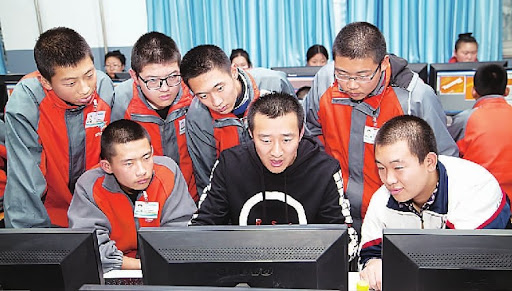Students majoring in animation listen to their teacher during a class at the Zhangjiakou Vocational and Technical Education Center. (Photo/Zhangjiakou Daily)
By Shao Yuzi, People’s Daily
The war epic film “The Battle at Lake Changjin,” which maintains a top spot in the Chinese mainland box office in 2021, has impressed moviegoers with its amazing special effects.
Zhangjiakou Saishang Culture Media Co. Ltd. based in Zhangjiakou, north China’s Hebei province, produced quite a lot of the special effects. “We completed 800 post-production special effects in the movie,” said Wang Xiqing, head of the company.
Wang was among the first batch of students graduating from the Zhangjiakou Vocational and Technical Education Center with a degree in animation (post-production). The 50 team members who took part in post-production of “The Battle at Lake Changjin” are all graduates from the school, having a shared identity as “animation experts in Zhangjiakou.”
Since the Zhangjiakou Vocational and Technical Education Center launched the major of animation in 2001, it has cultivated over 3,000 high-quality talents specializing in cartoon, games, design and post-production of movies for more than 100 domestic enterprises, building a distinctive labor service brand in the locality.
The secret for the success of the labor service brand lies in the strategy which focuses on cooperation between school and enterprises and integration between industry and education, according to Wang Zhidong, vice principal of the Zhangjiakou Vocational and Technical Education Center.
“The courses are solidly designed and the teaching content perfectly meets the requirements of the industry that I want to be in after I graduate,” said 21-year-old Jia Yuting, a student of game arts. After two years of learning of the professional knowledge, Jia has become well-versed in games design.
Nowadays, animation has become a popular major among the students because what the school teaches is job-oriented. However, at the beginning, animation was not as popular as it is now due to difficulties such as a lack of teachers and an incomplete curriculum system.
“We take the demands of the enterprises as educational standards,” said Wang Zhidong, who added that by carrying out investigations and surveys multiple times, they found that the key to break the bottleneck was to conduct in-depth exchanges with enterprises, knowing about their needs, and establishing a cooperation mechanism with them.
Before the first animation class opened in 2001, the school sent some backbone teachers to Beijing to take part in a training program that lasted nearly three months. It also cooperated with enterprises by inviting best technicians from the latter to give lectures to the students and work with the school’s teachers on curriculum development.
The cooperation yielded results quickly. To better meet the demand of the market, the school expanded the animation major from covering only the subject of animation to covering six subjects including game design and production, and post-production of movies, establishing a complete set of curriculum system for each subject.
“The animation market is constantly changing, and the enterprises are also upgrading technologies they adopt,” said Wang Zhidong, explaining the reason why the school chose to cooperate with enterprises in talent cultivation.
“In the first two academic years, the students will be taught drawing and sketching, as well as other basic courses, by their teachers, and in the third academic year they will study core courses while taking part in projects launched by the enterprises. The school will also invite the enterprises to take part in its teaching program, with the latter sending some of their best technicians to come to the school and help the students access knowledge from the latest trends of the industry,” Wang Zhidong introduced.
To improve the efficiency of the market-oriented education program, the school built full-size workshops of the enterprises on campus and the two sides jointly established a practice base for the program of the integration of industry and education that covers 860 square meters.
“At the base, the students can know what the experience will be like to work as an employee and take part in projects operated by the enterprises,” said Wang Zhidong. So far, the students and their teachers have taken part in and completed more than 300 projects operated by the enterprises. Moreover, they’ve also contributed their efforts in the post-production of 140 animated cartoons, including the well-known Chinese cartoons “The Monkey King” and “Pleasant Goat and Big Big Wolf,” and more than 60 hit movies including “Transformers 3” and “Wolf Warrior II.”
“We kept the passageway through which the students moving from finding internship positions to getting employed unimpeded, enabling them to get a full-time job offer from their internship,” said Wang Zhidong.
Wang also disclosed that each subject under the animation major has a designated teacher in charge of dealing with matters associated with internship, who will first learn about the needs of the enterprises and the market and then work out a list of companies that can provide suitable job openings. Under the concerted efforts of the school, the enterprises, and all other relevant parties, the school has established close partnerships with more than 40 top-notch companies in Beijing, Shanghai and other places in the country, providing a wider range of choices for the students to find the most suitable jobs.



